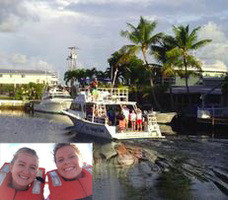| It's daunting trying to write and comprehend everything that's happened today. Arrived, Alive and Well Underwater is below. It's almost unreal. I've imagined today, descending to Aquarius as a home underwater, over and over, and -- after training and hearing of other's experiences, I imagined it pretty much exactly as it was. Nothing was much of a surprise, except for maybe the slight butterflies in my stomach. In the image left, I had just made my bunk and was viewing fish from the viewport. A shark swam by right after I snapped this photo. |
EARLY MORNING
I woke up at 5:30am to organize gear going down to Aquarius, both my personal items and research equipment, and put together all the things that will stay at mission headquarters. It was a night of little sleep. Last night I was up late with the Edgertronic high speed camera we'll use for research. The underwater housing for the camera, from the Sexton Corporation, arrived yesterday and in the day's chaos I didn't have a chance to play with it until after dinner in the Aquarius habitat.
| Unwrapping the camera housing felt like unwrapping a birthday gift. Billy, Brian, and Mike from our production team stayed up with me to gawk over the camera and housing. It's really a special piece of equipment. Doc Edgerton from MIT was with Jacques Cousteau on Calypso in 1954, and now as an MIT alum, I'm in Aquarius using Edgertronic with Fabien Cousteau in 2014! Lot's of history being made here. Before sending it underwater, I wanted to make sure, once again, that I understand the ins-and-outs of the Edgertronic camera and housing. Fortunately Sexton, the maker of the the underwater casing, thoroughly tested the case for us, and made everything as user-friendly as possible. |
Just to be sure, I inspected the case for any possible damages from shipping. I had packed supplies for greasing the o-ring seals on the case. In addition, the housing had to be disassembled prior to being loaded into the pressurization pods down to Aquarius because otherwise I wouldn't be able to open the housing inside Aquarius; the air pockets inside would have remained at 1 atmosphere, while the outside of the case would be at Aquarius's 2.5 atmospheres. (This is also one of the big differences between being in a submarine, which generally remains at a regular atmospheric pressure, and Aquarius, currently the world's only undersea research lab, where we've saturated to the surrounding ocean's pressure and therefore can spend extended time outside the habitat conducting ocean research.)
BON VOYAGE!
| Northeastern Professors Mark Patterson and Brian Helmuth, both former aquanauts, and their graduate students joined us yesterday for dinner, and this morning they waved us "bon voyage" from the dock at 7:30AM. They'll be in the water with us, conducting research via surface dives (about 45 minutes to avoid need to decompress), for the remainder of the mission. In addition, we're in regular communication about research procedures and goals. Liz and I enjoyed the wind and sun on the boat ride out to our new home. |
AQUANAUTS SEE THE SUN ... NO TURNING BACK
| Adam was the first to resurface. He arrived with arms open, in the victory pose. I can't imagine what it must be like to finally feel the sun and breath air from an endless sky after over two weeks. I'll know what that's like soon enough, however. We gave all the returning aquanauts (i.e., Adam, Andy, and Kip) hugs as they boarded the boat, ready to make the journey back to shore. I asked them humorously, "Guys, should we really do this, or turn back now?" Without hesitation, they all said Aquarius is worth it. Go! There's nothing like what we're about to do. |
TRADING SPACES & WORKING UNDERWATER
As I'm writing this, I'm sitting at the Aquarius kitchen table. Dozens of fish swim by the window at by my side. It's unreal, like one of those visually-addicting screen savers. I'm torn between just watching them, and reflecting on the day. Briefly, today was busy; after getting situated in Aquarius, we made our dive plan then executed a 3.5 hour saturation dive setting up plankton traps, finding sponges, and observing fish. Northeastern divers met us in the water this afternoon to deliver some equipment. Specifically, we deployed a dozen plankton traps for Amanda's zooplankton research, and carefully recorded each location. We also collected the last of the environmental contamination sensors, and attempted to use a CTD cast (more about that later... when it's working). Finally, in our dive helmets we joined Fabien (from inside the habitat) on a Skype call with Northeastern University. How cool is that?! That's the longest dive I've ever done. Tomorrow I'll discuss more details on the research.
After the long dive, I worked with our resident expert photographer Matt on the Edgertronic camera.
After the long dive, I worked with our resident expert photographer Matt on the Edgertronic camera.
| See the difference the Edgertronic high-speed camera can make! Water drops I filmed with the camera. | Water drop I filmed with regular video from my iPhone at MIT's Edgerton Center in May. | Fish filmed through Aquarius viewport, 500 frames per second. We haven't perfected the graininess (ISO setting) or focus yet, but that's coming with underwater tests. |
Goodnight, but first...
Here's a fun fact. Three of the six aquanauts in Aquarius right now are left-handed! That's statistically pretty crazy. Guess who...






 RSS Feed
RSS Feed
